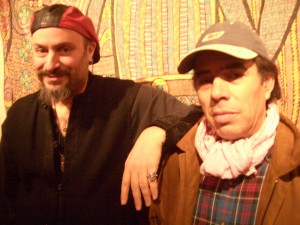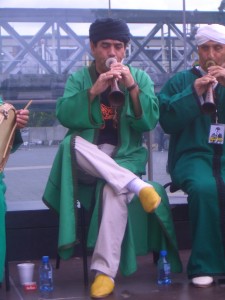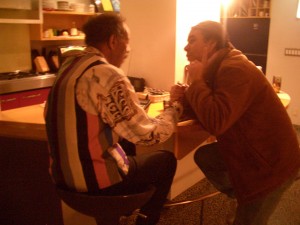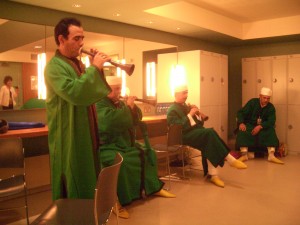by John Kruth
It had been quite some time since THE MASTER MUSICIANS Of JAJOUKA last came to town. In fact they hadn’t been around much at all once W laid siege to the White House. For most Americans the Bush “error” came to an end when the fat lady (Aretha Franklin) finally sang at Obama’s inauguration on the cold morning of January 20, 2009. But for a couple hundred New Yorkers the deal was finally sealed on Saturday, February 28th when THE MASTER MUSICIANS climbed on to the small stage of the Knitting Factory, draped in green djellabas, wielding their piercing pipes and thundering drums.
The following piece was originally written for Signal To Noise back in the earlier part of this strange decade. It appears in Doo Bee Doo Bee Doo once again (with a few changes) to whet your appetite for Augusta Palmer’s new documentary on her father, the great music journalist (and inspiration on yours truly) Robert Palmer. Make sure you see The Hand of Fatima and please come to Le Poisson Rouge (158 Bleecker Street, NYC) on Monday, November, 16th, 2009, where I’ll be joining Bachir Attar, Anthony DeCurtis, Augusta Palmer, Lenny Kaye, THE TEHRAN-DAKAR BROTHERS for an evening of music, readings from Blues & Chaos: The Music Writing of Robert Palmer – edited by Anthony DeCurtis and published by Scribner, and clips from Augusta’s film The Hand of Fatima.
It was nearly four p.m. on a hot August afternoon in New York City when Mustapha Attar and I sat outside on a sunny sidewalk sipping mint tea as he meticulously tied a new reed to the mouthpiece of my ghaita. After getting it just right, he put the wooden oboe to his lips and blasted a piercing riff that echoed off the Soho storefront windows. Although we were well within earshot of his brother Bachir, sleeping in the basement of a souk called the Gates of Morocco, the charismatic leader of what that cranky old junkie genius William Burroughs once dubbed “the four thousand year old rock and roll band” showed absolutely no sign of stirring. I finally had to lure the jet-lagged Berber from his bed with the smell of a big cup of hot black sugary coffee. His hair, still wild with dreams, Attar sat on the edge of the couch and lit his first Marlboro of the day. “What is your first shitty question?” he asked with a raspy laugh and bleary eyes. Bachir left me no other choice than to come out of the box and nail him on the hazy future of his village’s unique music. He slowly exhaled a big cloud of smoke and contemplated the question that’s relentlessly dogged him.
“Yes, I know,” Bachir replied wearily. “Many people ask this question. They care about the music, which is very good. But after many thousands of years, maybe there is an end!”
In this day and age when the average life span of a band is about as long as their new video and rock and roll relics like Bob Dylan and THE ROLLING STONES are admired for lasting thirty years, maybe a four-thousand-year run isn’t so bad after all. Bachir is an intense fellow. He’s got an air of gravity about him befitting a U-boat captain or a lone sheriff of the Wild West. Not that he’s currently dodging bullets or torpedoes, but even while partying, Bachir seems like he’s watching his back. His onyx eyes either sparkle with laughter or can shut out the world faster than smoke-black windows on a passing limo. But along with the daunting responsibility of keeping the legacy of Jajouka alive, this man has one of the greatest gigs on earth – playing the sexy – rhythmic – trance inducing – soul freeing music of Bou Jeloud (AKA “The Father of Fear”) the Goat god, Pan.
On their last American tour in the fall of 1999, the MASTER MUSICIANS consisted of just ten members. In Jajouka, at the height of its power the band numbered fifty musicians. “From the time (artist/author/inventor) Brion Gysin and (author/composer) Paul Bowles visited the village until the early sixties there were fifty. But now all those people have died,” he lamented.
The Attar brothers, now in their mid thirties, are the youngest members and driving force of the djellaba-clad ensemble. Part of the dilemma they face is that the musicians must be from the village of Jajouka. “Times have changed,” Bachir continued, pouring the take-out coffee from the disposable styrofoam cup into a more dignified gold leaf edged Moroccan tea glass. “The music must be passed from father to son. Now the children grow up and go off to school. They find other interests than playing ghaita and carrying on the tradition. But we are thinking of building a school in the future for the kids so they can learn this music.” Thus began a lengthy discussion about the difficulty involved in teaching the music as it has never been written down and the possibility of a concert to raise the money to create a cultural institute similar to Ali Akbar Khan’s school in Northern California.
Bachir and THE MASTER MUSICIANS have collaborated with some pretty heavy hitters over the years – including THE STONES, Ornette Coleman, (Coleman & Masters Of Jajouka 04 Midnight Sunrise [Alternate Take]), SONIC YOUTH and Bill Laswell to name a few. The possibility of an all-star gala seemed like a great idea until suddenly Attar became annoyed.
“Ugh, stars! I’m very tired of stars,” he groaned, scratching the two-day stubble on his chin. “There is an old saying in Jajouka. If the moon loves you, don’t worry when the stars move away.”
On the coffee table beside empty tea glasses and an ashtray overflowing with crumpled cigarette butts lay a color copy of a photo that appeared in Rolling Stone. There stood a shaggy Joe Perry of AEROSMITH hangin’ out backstage with THE MASTERS looking regal in their turbans and djellabas. Years ago R&B diva Aretha Franklin asked the age-old question, “Who’s zoomin’ who?” This picture had to make you wonder. Not that I question Mr. Perry’s fondness for Jajouka or its music. I’m sure Joe like so many musicians, painters and poets of the west got one earful of Bou Jeloud’s blues and fell eternally under its spell. In fact Joe offered a rather insightful quote about the music, calling it “trance inducing, hypnotic and primal.” It’s just that THE MASTERS like so many other musicians from Africa, Brazil and India have both benefited and suffered under the current trend of “musical colonization.” There is little doubt about that magic third-world bards have worked on pop platters by Paul Simon, Peter Gabriel and David Byrne. Personally, I can’t remember much about THE STONES’ Steel Wheels other than THE MASTERS’ chilling ghaitas on “Continental Drift.” But hey, if it takes Joe Perry to bring Jajouka to the pages of Rolling Stone, that’s all right with me. In the meantime, Bachir and the brotherhood lend some credibility to a rock and roll bad boy who’s lately been shilling for Dodge trucks.
“You see, the musicians love the music,” Bachir said, pointing at the photograph in my hands. “But I would like more people to understand Jajouka. I think some people, it makes them scared. They don’t know what’s happening and they start to shake… What’s this?” Bachir said laughing loudly. “People need to hear this music and open their hearts.”
Contemporary classical composer John Corigliano whose Pulitzer Prize-winning Symphony No. 2 and Altered States soundtrack have been influenced by everything from Mozart string quartets to the wailing ghaita of the Rif Mountains described JAJOUKA’s one-of-a-kind music as “a beautiful visceral experience. You can feel the reeds vibrating in your body. It’s an exciting human communication unlike most of today’s music.”
“I call it universal soul music,” said Genesis P-Orridge (of THOBBING GRISTLE, PSYCHIC TV and most recently THEE MAJAESTY) grinning with a mouthful of gold teeth.
“The music was a gift from a man named Attar to Bou Jeloud who came from the mountains. He was half man/half goat. He heard Attar’s flute music and said to him, “Oh play for me, I can dance for you!” So Attar played for him. That is why the music is called Bou Jeloudia. It was music just for this man who dances in goat skin,” Bachir said, explaining the roots of Jajouka’s singular music.
Bou Jeloud’s got his mojo workin.’ He is a holy healer doing a shaman’s shuffle that cures sterility and insanity. According to legend, if he whips a woman with the leafy switches he carries in each hand, they will become pregnant and give birth within the following year.
“For many years sick, crazy people come to Jajouka. Doctors cannot help them. They are tied to a tree and when they hear the music they become normal,” Bachir said with a shrug. There is little doubt the cleansing fire pouring from the bell of the ghaita could drive the evil from the most demonic of us human beings.
If Brion Gysin opened the door for Brian Jones, then Jones threw open the gates of Jajouka to the world when he recorded the maniacal melodies of Pan. “It was not a festival when Brian Jones comes,” Bachir clarified. “The musicians played for him and the engineer of THE STONES (George Chkiantz). I was five years old. I remember they had this big reel-to-reel tape recorder and Brian was dancing with the headphones on. It was incredible.”
In celebration of the man with the strange clothes and big blond hair, a goat was slaughtered and a feast was soon prepared. Bachir repeats the story again that is quickly becoming a chapter in mythology of the modern world.
“The goat had white hair over its eyes, like Brian,” Attar recalled. “When he saw it he told Brion Gysin, ‘This goat looks like me!’ Then they ate a shish kabob with its liver. And he said to Brion Gysin, ‘This is my liver.’ Not one year later he passed away,” Bachir said in a whisper.
But how did Attar’s father Hadj Abdesalam and the rest of the band respond to Brian Jones Presents the Pipes of Pan at Jajouka album when it was finally released in 1971? Until Brian Jones came along field recordings had an academic air about them. The idea of manipulating Mississippi field hollers or Javanese gamelan orchestra recordings was not only unheard of, but would have been deemed sacrilegious at the time by the few purveyors of world music recordings, such as Nonesuch and Smithsonian.
Heretic or not, Jones added his special sauce of phase and reverb to the wailing raitas and rhythmic drums so the rest of the world might experience the wild sound as he heard it dancing in his head during his brief visit to the Rif Mountains. But was Jones tampering with tradition when he messed with the mix?
“Oh it was only a little echo,” Bachir protested. “We loved the sound because it became very psychedelic. And because it was Brian’s idea. He was the first of the rock and roll people to make ‘world’ music.”
Jones, a multi-instrumentalist best known for his guitar and harmonica work on early STONES albums, began spicing Jagger/Richards songs with an array of exotic folk instruments from around the globe including sitar, dulcimer and recorder. Brian must have felt an immediate rapport with THE MASTER MUSICIANS OF JAJOUKA, a band of multi-instrumentalists themselves. “Brian was a big fan of many instruments. He played saxophone,” Bachir pointed out. With the Masters it seems to be the rule more than the exception to play a handful of instruments. Attar himself plays ghaita (Arabic oboe), gimbri (4 string lute) and lira (wood flute) as well as banjo and guitar and a bit of harmonica (though he claims the blues are not his domain, he clearly held his own at a recent late night jam.)
Ten years before the arrival of the infamous Rolling Stone, THE MASTER MUSICIANS had a gig as the house band at Brion Gysin’s restaurant, The 1001 Nights. Paul Bowles, author of the classic novel The Sheltering Sky, originally invited Gysin to Morocco as his guest. Bachir recalls: “When Brion heard JAJOUKA he said, ‘This is the music I want to hear for the rest of my life!”
Bowles not only introduced his friend to the music of JAJOUKA but also helped him financially when Gysin decided to open his restaurant.
“This is a story that nobody knows,” Bachir said smiling. “Actually it was Paul Bowles who first wanted to produce a JAJOUKA album. JAJOUKA was at One Thousand One Nights playing. Paul Bowles, he loved Jajouka music very much. He bring his equipment to record JAJOUKA. Brion Gysin he said to Paul Bowles, ‘No! You can’t record this. This is mine!’ Paul Bowles was angry and took his equipment away. Then he went and recorded all the Moroccan music he could find. And Brion Gysin, he was very jealous! But still they loved each other. Paul loved Brion’s paintings very much. He thought he was the greatest painter.”
Next up the steppes of the Rif mountains in search of inspiration came the brilliant, idiosyncratic alto saxophonist, Ornette Coleman. Coleman first heard the Brian Jones album courtesy of his friend (the late journalist/author/clarinetist) Robert Palmer. “Ornette loved the music and put Jajouka on his record” (Dancing In Your Head), Bachir said proudly.
It was a collaboration that clicked from the start. Coleman’s unique theory of music he dubbed Harmolodics (branded as cacophonous by stick-in-the-mud critics and old-school jazzers) seemed to fit hand in glove with the swirling ghaitas and propelling drums. Ornette also felt a deep connection with the musicians as well. Not five minutes after mentioning his name during our interview, Coleman was on the phone, as if by magic, calling to welcome Bachir back to New York.
After their brief conversation Attar returned to the sofa, lit another cigarette and began to talk about his old friend Bob Palmer who he felt understood the music on a profound level. Palmer so dearly loved the music of JAJOUKA that after his untimely death, he was cremated wearing a Moroccan djellaba with his ghaita clutched firmly in his hands. “My experience with JAJOUKA was in the Seventies,” Ornette told me recently. “ Robert Palmer, a dear friend, sent me a tape of the music and asked me if I’d like to go and participate. I was there for three weeks to a month [in January, 1973]. At the time Bachir was very young. I knew his father.”
“As a child when I saw Ornette in the village, it was the first time I ever heard JAZZ music,” Attar explained. “He played with my father and all the musicians that have [since] passed away. The music was magic, from another dimension that people, I think, will understand in the future.”
In November of 1991 Bill Laswell traveled to Jajouka and set up a digital 12 track in the foothills of the Rif to record Apocalypse Across the Sky. The album stands in stark contrast Brian Jones’ psychedelic field recording. Instead of a mad rushing whirlpool of pure sound that envelops your soul, Laswell presented short polished pop versions of JAJOUKA’s transcendental jams. The sound has a pristine, almost bell- like quality.
More recently Bachir and the brotherhood collaborated with Indian tabla player/DJ Talvin Singh who gave THE MASTERS a decidedly slick studio sound. Essentially Jajouka is spirit music that was born in nature. Bou Jeloud is the bull in a china shop who can’t restrain himself. The music has always seemed out of place indoors – be it a studio or a concert hall. “To hear the music of Jajouka played live in caves and mountains of is best!” Bachir reminds us. “Brion Gysin, William Burroughs, and Paul Bowles, they would sit for and listen for hours and hours.”
Most recently Bachir collaborated with the prolific composer Howard Shore on the soundtrack to The Cell. Shore’s earlier score to David Cronenberg’s dizzying film of Naked Lunch featured Ornette’s aching alto throughout the dark and surreal soundtrack.
Pulling one last ace out of his sleeve, Bachir revealed another dimension of JAJOUKA I knew nothing about. “There is music we play that you’ve never heard in America. It is called 55. It is classical music especially for the Kings of Morocco. It puts people in a deep trance and we cannot be responsible for what happens to them. I will play it for you if you come to Morocco. I have tapes from my father. There are fifty-five scales inside the music. Ornette, he completely understood it.”
“The music teaches people to look for pure things,” Bachir says in parting, “to find the truth and the truth is Allah.”






